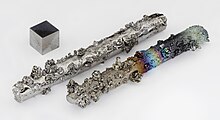
Back فقد اللمعان Arabic Anløbning Danish Anlaufen (Metallurgie) German Deslustre Spanish لکهدار کردن (تیرگی) Persian Tarnish SIMPLE
This article needs additional citations for verification. (January 2024) |

Tarnish is a thin layer of corrosion that forms over copper, brass, aluminum, magnesium, neodymium and other similar metals as their outermost layer undergoes a chemical reaction.[1] Tarnish does not always result from the sole effects of oxygen in the air. For example, silver needs hydrogen sulfide to tarnish, although it may tarnish with oxygen over time. It often appears as a dull, gray or black film or coating over metal. Tarnish is a surface phenomenon that is self-limiting, unlike rust. Only the top few layers of the metal react. The layer of tarnish seals and protects the underlying layers from reacting.
Tarnish preserves the underlying metal in outdoor use, and in this form is called chemical patina[2]. Unlike wear patina necessary in applications such as copper roofing, outdoor copper, bronze, and brass statues and fittings, chemical patina is considered a lot more uneven and undesirable[2]. Patina is the name given to tarnish on copper-based metals, while toning is a term for the type of tarnish which forms on coins.
- ^ Revie, R. Winston; Uhlig, Herbert Henry (2008). Corrosion and corrosion control: an introduction to corrosion science and engineering (4th ed.). Hoboken, N.J: Wiley-Interscience. ISBN 978-0-471-73279-2.
- ^ a b "Guide to Tarnish". Rio Grande. 2019-08-14. Retrieved 2024-08-17.